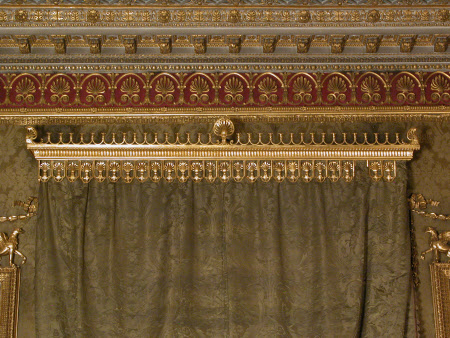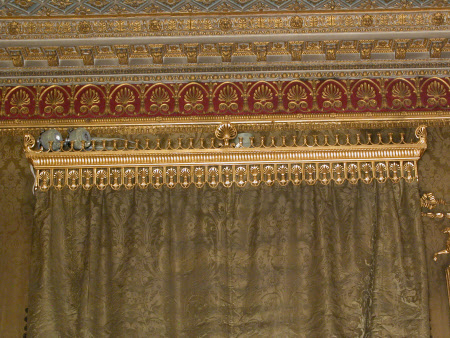Window cornice
probably Robert Adam (Kirkcaldy 1728 - London 1792)
Category
Furniture
Date
circa 1773
Materials
Giltwood
Measurements
33 x 198 x 20 cm
Place of origin
Berkeley Square
Order this imageCollection
Osterley Park and House, London
NT 771766.2
Summary
A carved and gilded window cornice, one of the three in the Drawing Room at Osterely Park, probably designed by Robert Adam (1728-92) and possibly made by John Linnell (1729-96). Surmounted by an arcade of crockets topped by calyx, and centred by an enclosed anthemion finial. The corners mounted with an enclosed anthemion acroterion. The frieze carved with enclosed flutes above an apron of lambrequins each enclosing an alternating palmette or anthemion supported by a calyx.
Full description
The window cornices in the Drawing Room at Osterley Park are thought to have been installed in 1773 when the room, having been originally designed and furnished in the 1760s (possibly under the auspices of the architect Sir William Chambers (1723-96)), was brought up-to-date by Robert Adam (1728-92). The calyx, anthmeia and palmettes embellishments are decorative features wholly drawn from the lexicon of neo-Classicism, the aesthetic movement drawing on the example of Antiquity which swept Europe from around 1750 and was totally dominant by the 1770s. Although Adam's drawings for these window cornices are not known to have survived, his designs for other elements of the room do. For instance, the design (NT 771573) for the magnificent carpet (NT 772424) made by Thomas Moore (fl. 1756-88) in 1774 is still at Osterley. In addition, the Drawing Room window cornices share similarities with other window cornices known to have been designed by Adam for other clients. Thus, for instance, the drawing by Adam which shows cornices designed for the Great Dining Room of the Duke of Cumberland's house at 86 Pall Mall, London share the same capping arcade of crockets of calyx (see Soane Museum, Adam volume 17/199), and the pendant lambrequins of the Osterley cornices are echoed in the cornices designed for the Drawing Room of 23 Grosvenor Square, the London house of Lord Edward Stanley (see Soane Museum, Adam volumne 17/110). They were probably made by the cabinet-maker John Linnell (1729-96) to whom much of the furniture at Osterley Park is attributed on stylistic grounds, there being no surviving bills or bank accounts covering furniture commissioned in the 1770s (the Child's are listed as debtors of William Linnell, John's father, on his death in 1763, and a later bill of 1782-3 survives) by Robert (1739-82) and Sarah Child (d. 1793). Other window cornices at Osterley also believed to have been made by John Linnell - those in the Yellow Taffeta Bedroom (NT 771802.1 - .3) and in the Eating Room (NT 771746.1-.3) - share similarities with the Drawing Room window cornices. John Linnell certainly designed and made comparable window cornices for other clients. A drawing by Linnell dated 9 December 1773 shows a window cornice apparently intended for The Reverend Mr Milner (V & A Accession Number E.3489-1911), whilst another (V & A Accession Number E.3512-1911) shows two window cornices labelled 'Puller' and 'Lytton'. None of these are identical to the Osterley Park cornices - the former is hung with pendant swags, not lambrequins, and the two latter both have urn-centred crestings - but all three share corners mounted with anthemion acroteria. A bill does survive for five gilded window cornices made by Linnell for another client, William Drake (1723-96) of Shardeloes, near Amersham, Buckinghamshire in 1768. Costing Drake £32 10s, giltwood window cornices - very like those the Child's are thought to have ordered from Linnell for various rooms at Osterley Park - were a significant investment; three painted window cornices ordered by Drake for his Eating Parlour cost just £5 14s. The window cornices in the Drawing Room at Osterley Park were listed in the 1782 inventory taken there as 'elegant Carved & gilt Cornices', but by the time the inventory of 1871 was taken their condition had worsened and they were described as '3 ornamental gilt cornices, slightly damaged'. Together with the Drawing Room's seat furniture and curtains, the window cornices are (as of 2022) being conserved by the National Trust.
Provenance
Listed in the inventory taken in Osterley Park in 1782 as 'elegant Carved & gilt Cornices' and in another taken in 1871 as '3 ornamental gilt cornices, slightly damaged'.
Makers and roles
probably Robert Adam (Kirkcaldy 1728 - London 1792), designer possibly John Linnell (1729 - 1796), maker
References
Hayward and Kirkham (1980): Helena Hayward and Pat Kirkham, William and John Linnell: Eighteenth Century Cabinet-Makers (Studio Vista: London, 1980), 2 vols., Vol. II, p. 163 Hayward, 1969: Helena Hayward, 'The Drawings of John Linnell in the Victoria and Albert Museum', Furniture History Vol. 5 (1969), 1-118 Kirkham, 1967: Pat Kirkham, 'The Careers of William and John Linnell', Furniture History, Vol. 3 (1967), 29-44, 29-44 Tomlin, 1986: Maurice Tomlin. “The 1782 inventory of Osterley Park.” Furniture History 22 (1986): pp.107-134.

